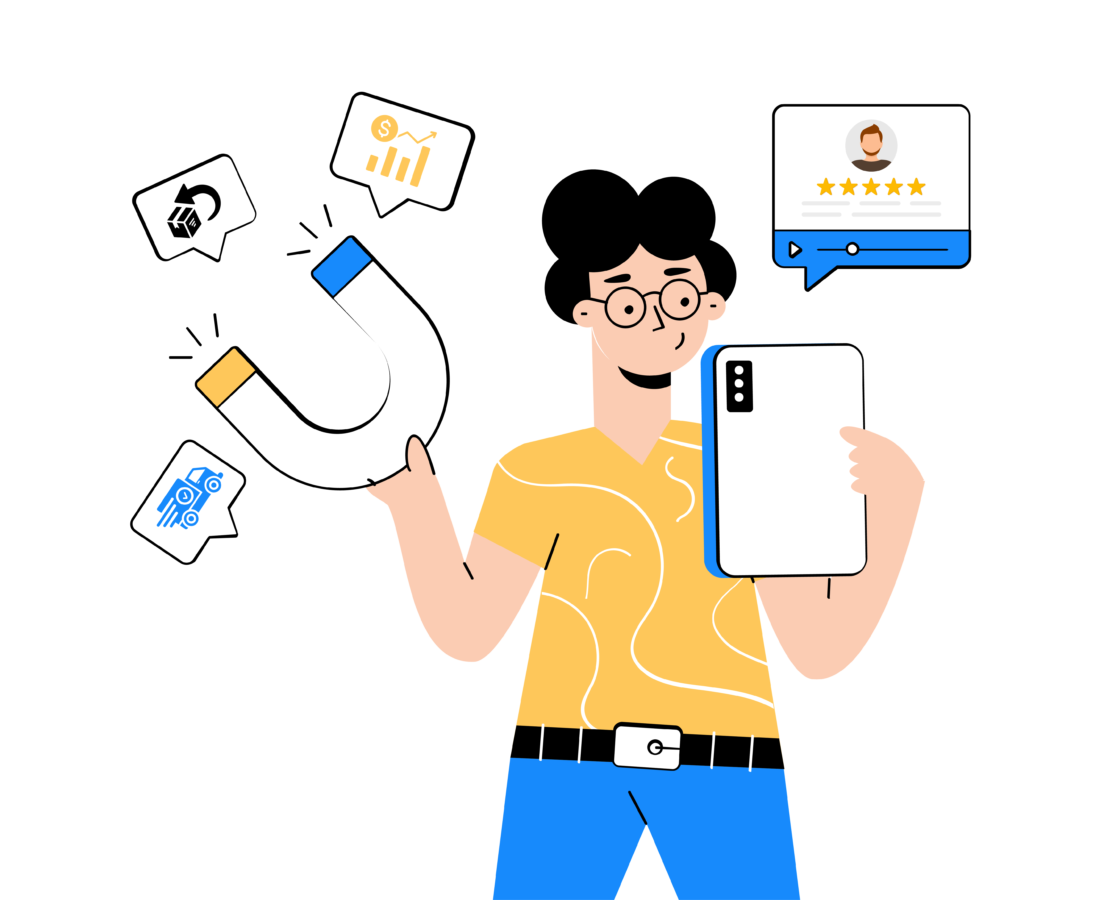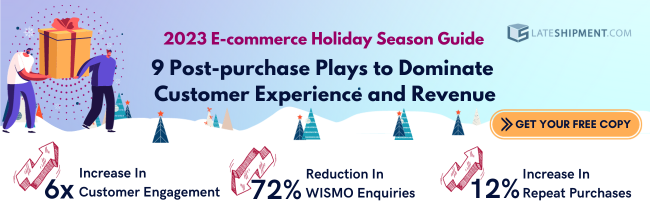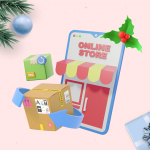Introduction
Holiday shoppers don’t just mean the “I’m planning to spend (more than I usually do during the other months) for my holiday season needs by capitalizing on seasonal trends, special deals, and promotions” type.
It covers impulse buyers — who make unplanned purchases motivated by emotional triggers such as peer pressure or “FOMO” from the holiday trends, gift givers — who are purchasing products for others, early bird or last-minute shoppers, and shoppers of different demographics (age, gender, spend threshold, etc).
Amidst all these characteristics, one thing that stands in common is the holiday shopper preferring to be just a one-time shopper.
The One-Time Shopper Dilemma
You might have faced this scenario where someone shops with your brand once and that’s all… you never hear from them again.
Unfortunately, in some cases, their decision to shop with you just once has something to do with you. This term is coined as “The one-time shopper dilemma”, where e-commerce businesses are unable to convert one-time shoppers into repeat customers due to unfavorable customer experiences.
76% of customers say that an unacceptable customer experience would affect their decision to order from the company again.
It is almost easy for one-time shoppers to get what they want. But in your case, not so much, given the increasing competition among e-commerce brands in today’s space.
Enter “Brand BFF” or repeat customer, a win-win situation for your customers and your business.
Why Focus on Customer Retention?
Overcoming the one-time shopper dilemma requires a comprehensive approach to address the not-so-positive experiences that:
- Arise from bad delivery experiences, lack of engagement and follow-up, etc, and
- Prevent you from increasing the likelihood of converting one-time shoppers into repeat customers.
To give you a little motivation, here are some of the benefits that you can stand to gain by increasing your customer retention rates.
- Cost-effectiveness: Retaining existing customers is significantly more cost-effective than acquiring new ones. Studies show that it costs 5 times more to acquire a new customer than to retain an existing one.
- Stronger customer relationships: Fostering strong customer relationships impacts multiple customer satisfaction metrics such as high customer lifetime value, positive brand perception, and increased brand advocacy.
- Competitive advantage: In a competitive landscape where similar products offered are similar, the experiences you offer play the differentiator. And with positive experiences, leading to higher retention rates, you now have a significant advantage over your competitors.
With the importance of customer retention clear, it’s time to focus on one particular component that is crucial to increasing your customer loyalty in the long run — ‘the post-purchase customer journey’.
Chapter 1: Mapping the Post-Purchase Customer Journey
The ‘post-purchase’ is an integral, but often overlooked function in any e-commerce business.
Integral because the experiences offered by you in the post-purchase phase occur in the final stages of the customer journey and thereby have a higher chance of leaving a lasting impression on your customers than CX offered in the pre-purchase and purchase phases.
On the contrary, most businesses don’t pay enough attention to post-purchase customer experience due to reasons such as:
- Businesses assume their job is done after handing over the package to the shipping carrier for delivery
- Businesses don’t recognize the post-purchase being a goldmine of opportunity to effectively engage customers
- Businesses often operate with limited resources, making it challenging to dedicate the time and effort required for effective post-purchase strategies.
Are you one of such businesses? No, it’s all good. If yes, you need to shift your commitment to prioritizing the post-purchase CX. And that process begins with understanding the ABCs of the post-purchase customer journey.
1.1: Defining the Post-Purchase Journey
A customer’s post-purchase journey is interactions with your brand that take place once the order is dispatched to when it is ‘delivered’ or ‘returned’.
In simple terms, the post-purchase customer journey usually takes place from the moment the buy button is clicked and the order is confirmed, till the moment it reaches the customer’s doorstep. In some cases, the post-purchase journey extends beyond order delivery, whenever the customer initiates a return on their purchase.
A successful post-purchase customer experience strategy is ensuring that your customers have hassle-free order delivery and return experiences with your brand that in turn help you nurture customer relationships and achieve sustainable growth. That said, let’s see why post-purchase is a huge missed opportunity for most businesses out there.
1.2: Key Touchpoints and Moments of Truth: Why Post-purchase is a Huge Missed Opportunity
There might be different reasons for Americans choosing to spend 39% less this holiday season from 2022. However, as for pain points, customers said they had several frustrations in the previous holiday season such as a lack of communication during the shipping process (57%), lost or damaged packages (51%), and delayed packages (49%).
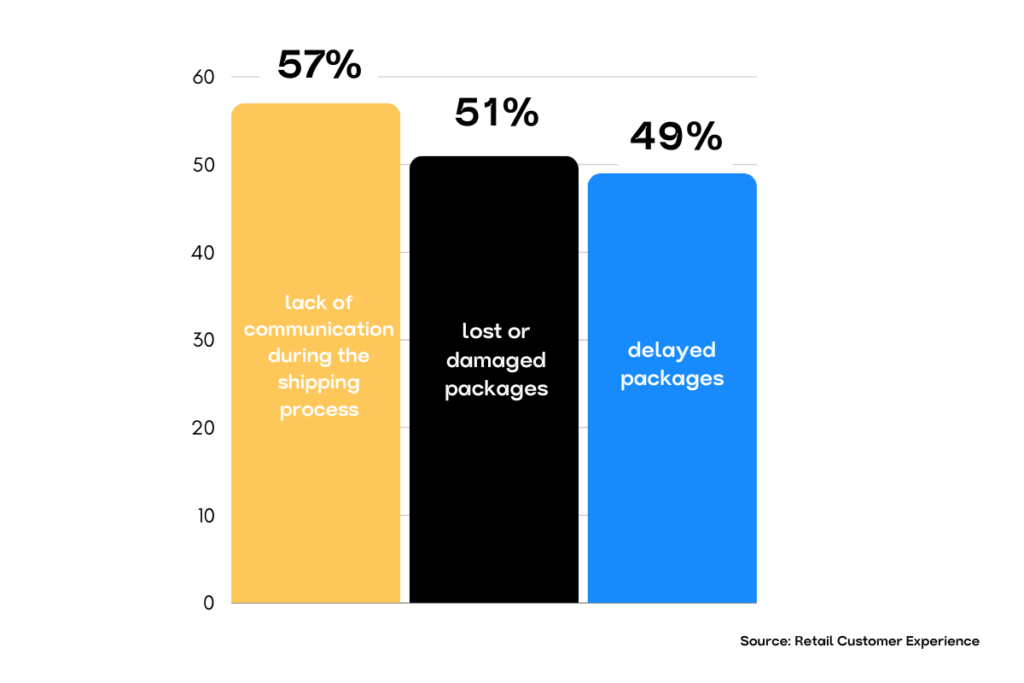
A harsh truth to digest is that issues are inevitable and common in the post-purchase phase and mind you, these issues hold serious power to hurt your customer’s satisfaction levels and lead to even more problems.
1.3: Understanding the Post-Purchase CX Challenge: Identifying Threats and Impact
Post-purchase issues may be common. But the real problem lies when you don’t do anything about it and let customers fend for themselves.
This brings up the necessity to maintain engagement and address customer concerns post-checkout. However, with most businesses like yours involuntarily not tending to these issues, there exists a disconnect or a ‘post-purchase CX gap’ that can lead to frustration, dissatisfaction, and ultimately, customer churn.

- Up to 20% of shipments face ISSUES such as late delivery, attempted-failed delivery, lost or damaged in transit
- Up to 40% of customer support inquiries are WISMO (Where Is My Order) or RETURN-related
- Up to 35% of all products that are purchased from e-commerce retailers are RETURNED
- 82% of shoppers are worried about their orders not reaching them on time
- 78% of shoppers won’t buy from the brand again after just ONE bad delivery or return experience
But there’s no need to stress — the upcoming sections will cover everything you need to know about creating an e-commerce post-purchase strategy that will improve customer experience, and boost customer retention.
1.4: The Power of Post-Purchase CX
Post-purchase issues tend to drive customers away. On the other side of the same coin, 46% of customers say that a positive post-purchase experience makes them more likely to buy from a brand again. That is the power of the ‘overlooked’ post-purchase CX — to make or break a brand.
- Increase in retention, brand reputation, and consumer spending: A positive post-purchase experience can make customers feel happy, valued, and appreciated. Such customers don’t just keep shopping with you but will recommend your brand to others and are also willing to pay more.
- Reduced customer support costs: With frequent and meaningful engagement throughout the post-purchase journey, you can minimize customer inquiries and reduce the need to contact customer support, thereby saving you time and money.
- Increase in revenue: By leveraging post-purchase interactions to the maximum and exceeding customer expectations, you can create and identify opportunities to upsell or cross-sell additional products.
With the significant benefits that you can reap by working on your post-purchase CX loud and clear, we’ll move on to the hero section of this article. How you can craft a successful strategy to optimize CX throughout your customers’ post-purchase journey.
Chapter 2: Crafting a Post-Purchase CX Strategy
Taking measures to close the post-purchase CX gap and provide customers with a frictionless delivery experience can cement you as their preferred brand.
Now the question one should ask is: On whom does the onus of closing the existing gap and perfecting the post-purchase really fall? The answer is: on everyone — from marketing to sales to operations and customer service.
2.1: Aligning Teams for Post-Purchase Success
- Support agents providing fast and exceptional customer service
- Operations team making better decisions to improve delivery performance and reduce returns
- Sales team using the post-purchase as an additional channel to drive revenue
- Marketing team sending effective and targeted campaigns based on customer history
Bringing all business functions together and taking a unified approach to post-purchase interactions is vital for your business to enjoy post-purchase success. But what does post-purchase success look like?
2.2: Metrics and KPIs for Post-Purchase CX
- Customer Satisfaction (CSAT): To measure customer satisfaction with the post-purchase experience through surveys, feedback forms, and online reviews. In 2023, E-commerce and retail had the second-highest benchmark for CSAT scores at 81.
- Net Promoter Score (NPS): NPS indicates the likelihood of customers recommending your brand to others. For the e-commerce industry, the average NPS is 45. That means you should aim for a 45 or higher score to succeed.
- Customer Lifetime Value (CLV): CLV represents the total revenue customers generate over their lifetime relationship with the brand. According to many e-commerce experts, LTV should be about 3x CAC.
- Return-related metrics: To monitor different metrics relevant to returns and exchanges to identify potential product or operational issues. Some must-know return KPIs for e-commerce businesses are Return rate, Reason for return, Frequently returned products, etc.
- Customer Support Resolution Time: A metric that directly impacts your CSAT and NPS scores — the average time it takes to resolve customer inquiries and issues. 61% of consumers define excellent customer support interaction as one with a quick resolution.
By consistently monitoring these metrics and KPIs, you can identify trends, assess the impact of post-purchase strategies, identify areas and make data-driven decisions for improvement, and drive long-term CX success.
Adopting the following ways to improve your post-purchase CX will ensure a positive impact on both your customers’ lifetime value and the retention rate of your business.
Chapter 3: Delivering a Seamless Order Fulfillment Process
The order fulfillment process is the first step in the post-purchase experience. It’s important to make sure that this process is seamless and efficient to avoid customer frustration.
Here are a few tips for delivering a seamless order fulfillment process:
3.1: Process Orders Quickly and Accurately
The order fulfillment process is the series of steps that take place after an order is placed until the product is delivered to the customer. While it can be time-consuming, when optimized with the right strategies it can help you improve customer satisfaction and so much more.
There are several strategies that e-commerce businesses can implement to improve their order fulfillment process:
- Optimize Inventory Management: Accurately keep track of inventory levels to avoid both stockouts and overselling.
- Partner with reliable shipping carriers: Partner with reliable shipping carriers to ensure timely and accurate deliveries. Each carrier like DHL, FedEx, and UPS has its pros and cons. Compare them and see what works best for your business.
- Make use of an Inventory Management tool: An inventory management software like Linnworks can help you automate processes and execute a seamless CX across the order fulfillment journey.
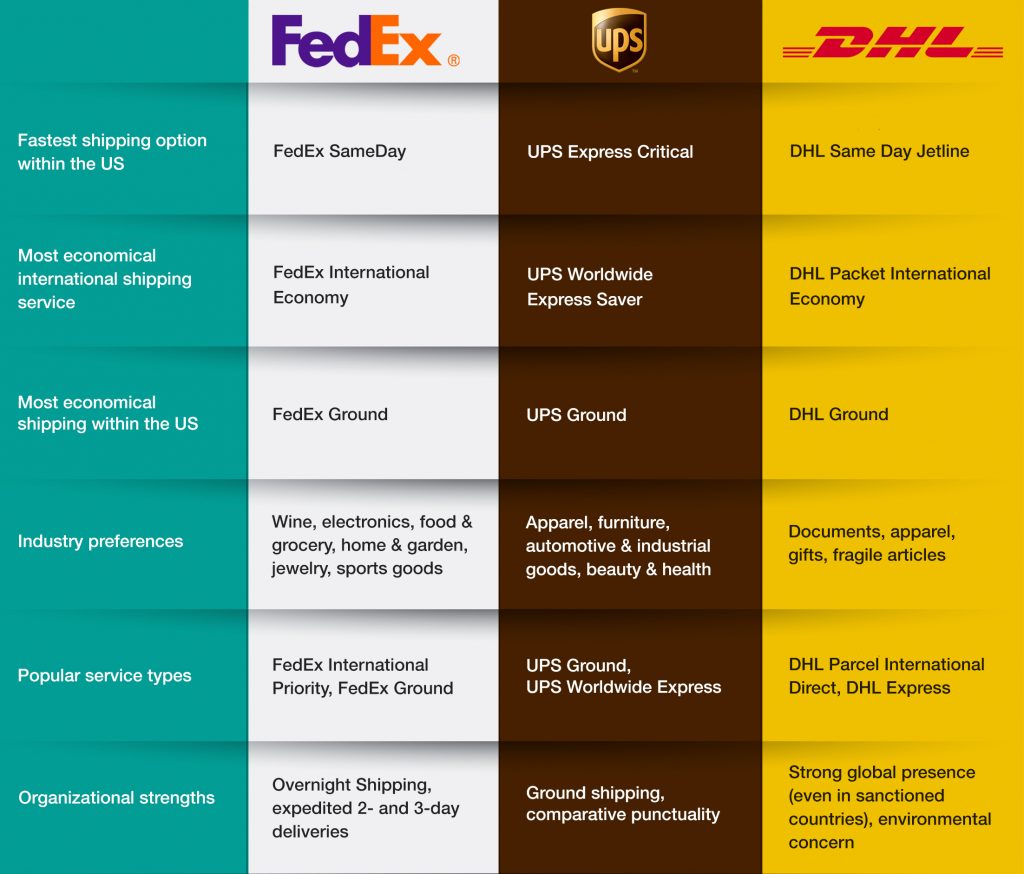
3.2: Provide Real-time Tracking Information
Providing real-time order tracking information to customers is a crucial aspect of delivering a seamless order fulfillment process. Here are some key benefits of providing real-time order tracking:
- Track your shipments across the carriers and 3PLs that you use: Gain real-time visibility of your shipments, even after packages have left your facility — across carriers, 3PL service providers, service types, and locations, to have a true and unified view of your fulfillment operations.
- Dive deep into delivery exceptions and on-time performance trends: Gain a commanding and consolidated view of all delivery issues and on-time performance trends to intervene before they can adversely affect your customers’ satisfaction levels and the efficiency of your order fulfillment operations.
TLDR; by prioritizing real-time order tracking, it is time to deliver a seamless and transparent order fulfillment process and enhance customer satisfaction.

3.3: Offer Multiple Shipping Options
By offering a variety of shipping choices, you can cater to different customer needs, preferences, and budget constraints, leading to reduced cart abandonment, and increased customer satisfaction.
- Identify customer preferences: Analyze customer data and feedback to understand the most popular shipping options and preferences among your target audience.
- Clearly display shipping options: Provide clear and transparent information about shipping options on product pages and during the checkout process.
- Accommodate special delivery requests: Offer options for expedited shipping, weekend delivery, or any other specific delivery instructions. This can come in particularly handy while catering to last-minute shoppers.
3.4: Handle returns and exchanges promptly
Making returns easier for holiday season shopping is the norm now as 98% of shoppers say that fast and convenient returns will make them more likely to order again. Here are a few strategies if you’re looking to keep up or even perform better than competing brands when it comes to order returns.
- Establish a clear and transparent returns and exchanges policy: Clearly outline the terms and conditions for returns and exchanges, including time limits, eligibility criteria, and return shipping instructions. Make this policy easily accessible to customers on your website, checkout page, and order confirmation emails.
56% of customers abandon their carts due to delivery and returns-related concerns.
- Communicate effectively throughout the process: Keep customers informed about the status of their returns and exchanges throughout the process. Send email notifications, provide tracking information, and address any inquiries promptly.
- Retain revenue by encouraging exchanges or store credits over refunds: Incentivize customers to exchange an item or accept store credits with additional discounts, rather than a refund to save a lost sale and retain profits.
- Streamline your returns processes: Utilize return automation tools to make tasks self-service, automate steps, send proactive status updates, etc, to reduce unnecessary returns workload on your support team as well as to make the process quicker.
- Analyze return and exchange data: Regularly review return and exchange data to identify trends, potential product issues, and areas for improvement in the order fulfillment process.
Remember, your customers are not always happy doing returns. Therefore, don’t make it more stressful for them. On the other hand, by making the returns and exchanges process as seamless as possible, you have the power to transform a potentially negative experience into an opportunity to showcase customer care and build lasting relationships.
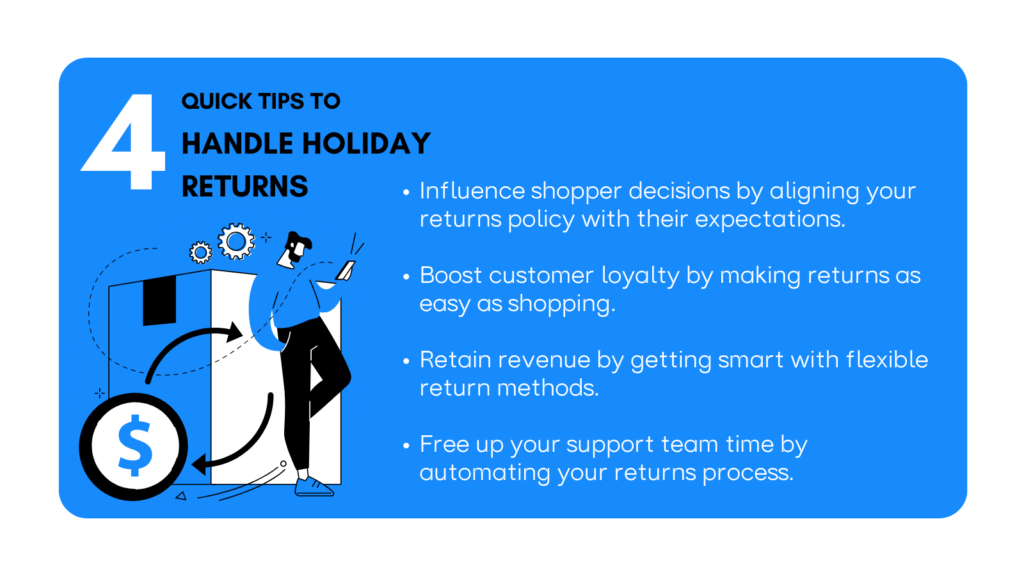
Chapter 4: Customer Support: Your Retention Superpower
Delivery issues such as delays being inevitable and carriers often withholding information to prevent themselves from being shown in a bad light highly increases the odds of your customers bombarding your support reps with frequent WISMO queries.
Customer support teams are overloaded with WISMO requests that make up approx. 50% of the overall customer inquiries.
On the other hand, with great customer support, you can effectively assist and resolve customer issues and open new doors for customer satisfaction and retention. Here are some ways for you to provide stellar customer support in the post-purchase phase.
4.1: Proactively Resolve Delivery Issues Before They Impact Your Customers
- Trigger proactive alerts: Whenever your customers’ parcels are facing critical delivery issues, such as predicted delays, suspect lost, etc, have tickets triggered to your helpdesk system to enable your support agents to proactively address the issue at hand.
- Arm your support team with data: Provide customer support teams with access to complete shipment tracking information to resolve delivery issues promptly. This empowerment ensures that customers receive timely assistance and issue resolution.
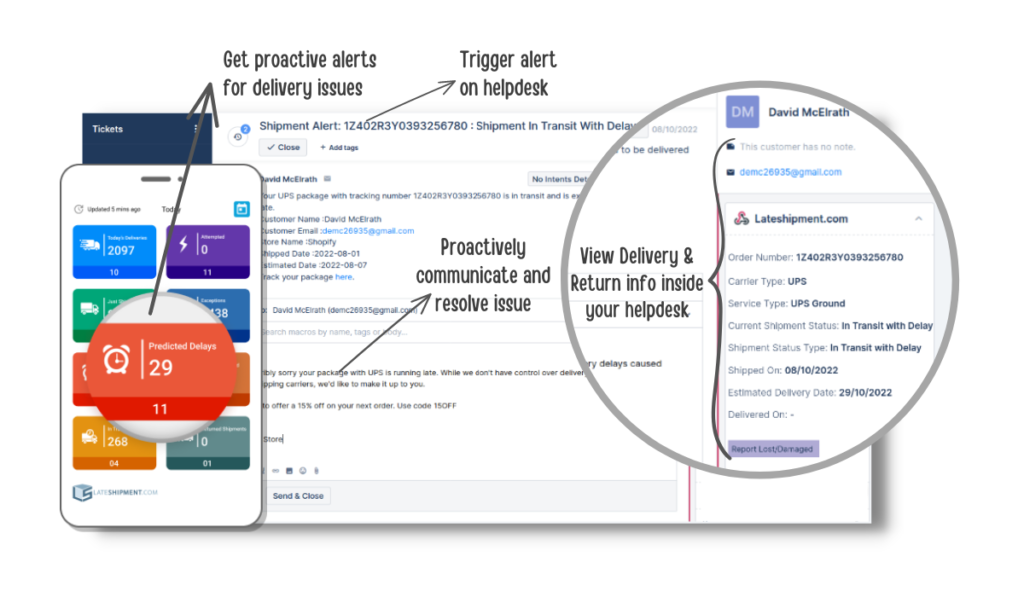
4.2: Turn Support Interactions into Opportunities
- Actively listen and gather insights: Engage in active listening during support interactions to fully understand customer concerns, pain points, and expectations. Use this valuable feedback to identify areas for product improvement, service enhancements, or process modifications.
- Personalize interactions: Tailor support interactions to individual customer needs and preferences. Use customer data to provide personalized recommendations, address specific concerns, and offer relevant solutions. This can foster deeper connections and increase customer satisfaction.
- Integrate support with marketing and sales: Collaborate with marketing and sales teams to share customer insights gathered from support interactions. Use this data to inform marketing campaigns, sales strategies, and product positioning to align with customer needs and preferences.
By leveraging customer data and insights, businesses can transform customer interactions into valuable touchpoints to gather insights, foster positive relationships, and demonstrate a genuine commitment to customer service.
4.3: Encourage Customer Self-service
Provide your customers with the tools and resources to resolve their own issues to free up your support team to focus on more complex and urgent matters. This can help in reducing support costs and improving overall efficiency.
- Branded order tracking experience: Customers track their orders 6-8 times before delivery. That’s valuable time that you can’t afford to miss out to re-engage with your customers and boost brand recall. For instance:
- You can host tracking pages on your domain and populate them with branded elements that ensure your brand stays at the top of their mind.
- Apart from the usual content such as order summary and tracking information, you can also go a step further in customer convenience and include options to contact support for emergencies or initiate returns/exchanges directly
- You can also include personalized product recommendations and run offers/sales to double your chances of driving repeat sales.
- Reduced support costs, Increased agent productivity: With customers having enough information at hand to manage their own support requirements, you can reduce the burden on your support teams, which can lead to lower support costs. Also, agents who’ve spent their time tending to unwanted inquiries can now focus on more complex and urgent matters, improving their overall productivity.
- Access to 24/7 support: With self-service options available to customers 24 hours a day, customers can resolve their issues whenever and wherever customers need them, without having to wait for support.

4.4: Leverage Customer Support Technology
Technology plays a crucial role in enhancing customer support by providing you with innovative tools and solutions to transform your customer support operations and create exceptional customer experiences.
- Utilize predictive analytics: Make use of technology that analyzes historical parcel data and forecasts potential disruptions such as delays and helps you take the right course of action before such issues impact your customer.
- Artificial Intelligence (AI) and Chatbots: AI-powered chatbots can provide 24/7 support by answering frequently asked questions, guiding customers to relevant resources, and escalating complex issues to human agents. Chatbots can also personalize interactions based on customer data and preferences.
- Help desk systems: Utilize help desk tools such as Freshdesk and Gorgias as a centralized platform for managing customer inquiries. This can help in empowering your support team to deliver lasting customer experiences, as well as simplify their operations by bringing in a structured way of prioritizing.
- Omnichannel support: Omnichannel support integrates various communication channels, such as phone, email, live chat, and social media, into a unified platform. This seamless integration allows customers to switch between channels without losing context and ensures that their inquiries are handled promptly and efficiently.
Ultimately, by effectively utilizing customer support as a retention superpower, you can strengthen customer relationships, reduce churn, and achieve long-term success.
Post-purchase interactions from your end don’t have to be only when something goes wrong. Even when everything is going your way, there’s an additional opportunity to boost engagement and reap its benefits.
Chapter 5: Email and Post-Purchase Engagement
A great way to build lasting relationships with customers is to keep them engaged and ensure that you remain on the top of their minds. And what better way to engage customers throughout the post-purchase phase than keeping them notified till their order reaches them.
5.1: Order Confirmation and Beyond
The ‘order confirmed’ notification is a priority for two things — assurance to the customer that their order has been accepted and kicking off the rest of the post-purchase shipping notifications to improve CX throughout the delivery lifecycle.
- Order shipped: Once the order has been processed and shipped, customers should receive a prompt shipping confirmation email, providing them with a tracking link or reference number to monitor the progress of their shipment. This proactive communication keeps customers informed and reduces the burden on customer support teams.
- Order In-transit: Throughout the shipping process, customers should receive periodic updates, either via email or SMS notifications, informing them of the shipment’s location, estimated delivery date, and any potential delays or disruptions. Real-time tracking links further enhance transparency and provide customers with a sense of control.
- Order out-for-delivery: Upon reaching the destination city or postal code, customers should receive an out-for-delivery notification, indicating that their order is on its way to their doorstep. This timely update allows customers to prepare for the package’s arrival and manage their schedules accordingly.
- Order delivered: Finally, upon successful delivery, customers should receive a delivery confirmation email or SMS notification, providing them with a final acknowledgment of the order completion. This closing touch reinforces customer satisfaction and encourages repeat purchases.
However, this is no longer the bare minimum as customers expect brands to keep them informed at every event of their package journey to mitigate their highly otherwise high anticipation levels. If you’re looking to exceed expectations, you need to proactively step up your game and leverage additional touch points in the order journey.
5.2: Post-purchase Shipping
In the order delivery and returns phases of the post-purchase customer journey, there are additional events for you to understand and implement in your existing email and SMS series:
- Delivered with delays: A fairly straightforward notification sent when the order is delivered exceeding the proposed timeline. Customers are more likely to forgive you for the delay, when you acknowledge the delay from your end along with a little apology note and a coupon.
- In-transit with delays: Tracking your orders in real-time gives you the opportunity to proactively identify and resolve delays before your customer is impacted by them. For high-value customers, you can go a step further and send out replacements via expedited shipping options, so that your customers don’t end up losing them.
- Failed delivery attempt: When a delivery attempt is made and yet the order does not reach the customer’s hands, the onus of handling the issue is still on you. Whenever a delivery is re-attempted you have to shell out a few extra dollars as re-delivery charges. Therefore, avoid additional re-attempts, by keeping customers informed.
- Delay predicted: Maximizing real-time order tracking and predictive analytics, gives you the opportunity to keep the customer informed when there is a possibility of a delay (which might turn out resolved on its own) to stay on the safe side. This ensures that the customer knows that you are on top of their order and will be less anxious regarding it reaching them on time.
- Suspected to be lost: Despite state-of-the-art tracking systems, packages can still end up somewhere else than the required destination. When you suspect a package to be lost, the first thing that you must do is notify your customers at the earliest.
- Order lost/damaged: In case your worry turns out to be true and the package ends up lost in transit/ damaged upon being received, you must prioritize notifying customers at the earliest and try to offer a prompt resolution. You can also go a step further and bear the cost of returns and send out a replacement at your own cost and provide discounts or coupons for future orders.
- Return notifications: Similar to delivery status notifications, you can also keep customers in the loop of their order returns by sending emails and SMS:
- When they initiate a return
- When their return request is accepted, rejected, or canceled
- When the return order is in-transit, and
- When the returned order is received at your facility
Remember, engaging with your customers when they are not very excited is the perfect time for you to revive their trust in your brand and strengthen relationships.
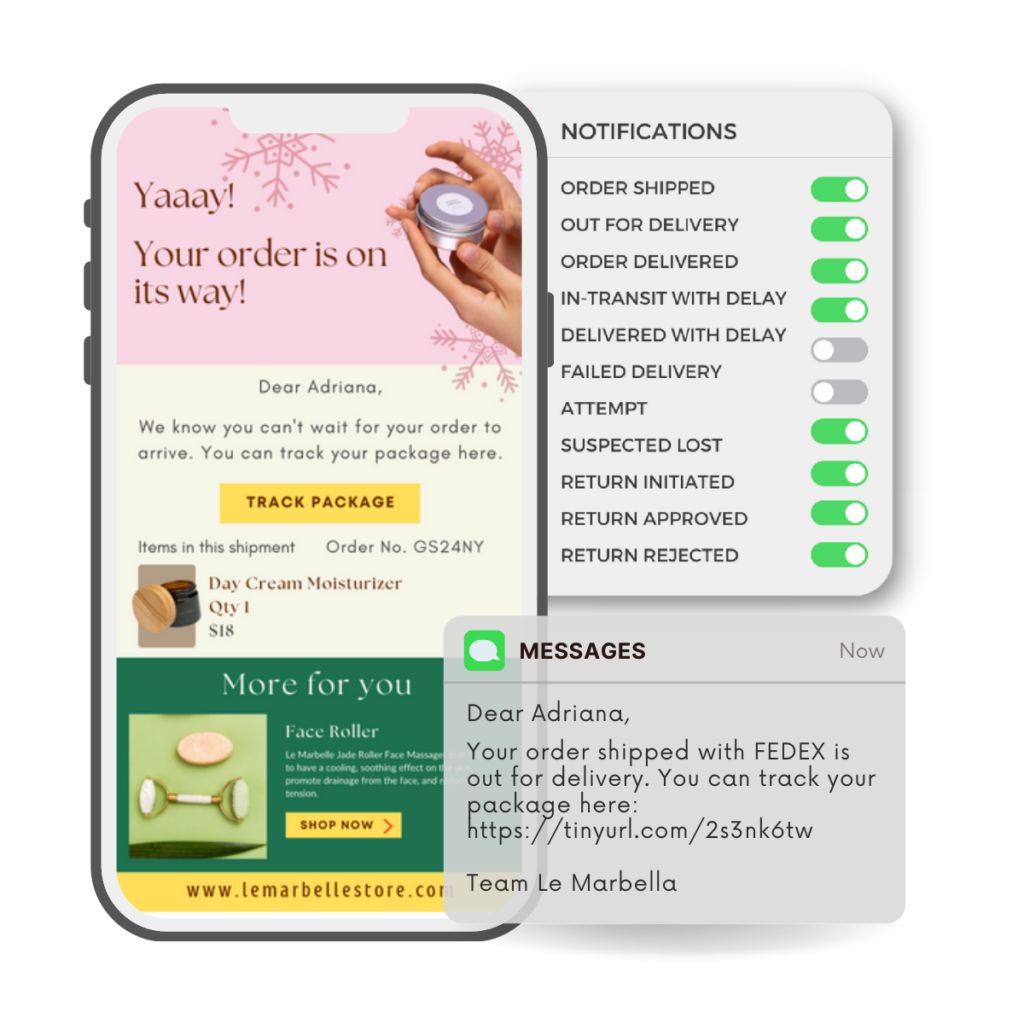
5.3: Nurturing Customer Relationships Through Email
- Keep sharing product recommendations (Cross-selling and upselling): Utilize customer purchase history and identify preferences to send personalized product recommendations. You can also suggest complementary products, accessories, or new releases that align with their interests.
- Educate your customers via ‘how-to’, tips and tricks emails: Share product tutorials, usage guides, or tips and tricks to help customers maximize the value of their purchases and enhance their overall experience.
- Provide exclusive offers and loyalty rewards: Reward customers with exclusive offers, discounts, or loyalty points based on their purchase history or engagement levels. These personalized incentives encourage repeat purchases and strengthen customer loyalty.
- Send ‘thank you’ mails and feedback requests: Express gratitude for customer purchases through personalized thank-you emails. Include feedback requests to gather valuable insights into their experience, identify areas for improvement, and demonstrate a commitment to customer satisfaction.
Post-purchase email is not just about confirming orders and providing usual updates; it’s about building lasting connections, fostering positive experiences, and cultivating a loyal customer base that contributes to sustainable business growth.
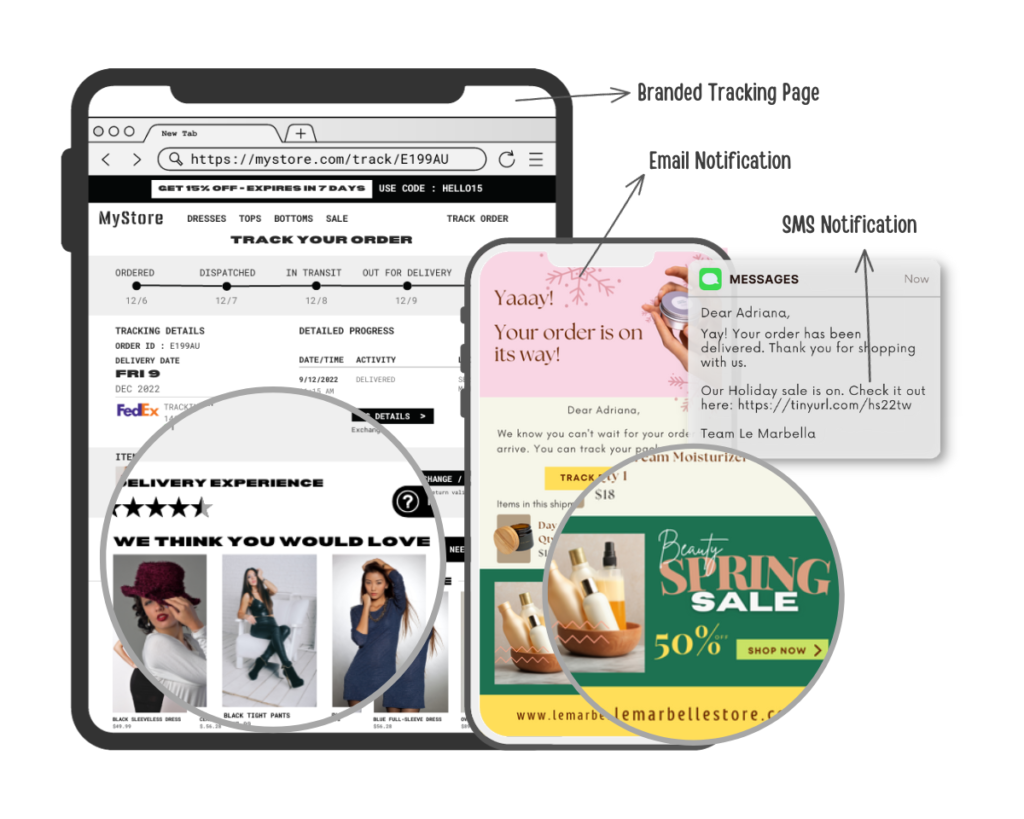
Post-purchase CX: The Path to Lifelong Customer Relationships
In the ever-evolving landscape of customer experience (CX), post-purchase interactions play a pivotal role in forging lifelong customer relationships and driving retention.
- Prioritize customer satisfaction beyond the point of purchase to transform fleeting transactions into enduring connections.
- Embrace evolving strategies and stay attuned to customer expectations to achieve sustainable growth in the ever-evolving world of customer experience.
Appendices
Getting started on implementing these strategies is the first step to turn one-time shoppers into your brand’s BFFs.
But wouldn’t it be even better if there were solutions to automate all these tasks on your behalf?
Meet LateShipment.com’s post-purchase suite — to help you provide delightful delivery and return experiences to automated refund recovery and drive everything post-purchase from one place.
LateShipment.com is a post-purchase automation platform built for D2C e-commerce businesses to offer superior CX throughout delivery & returns, effortlessly recover refunds for shipping errors by carriers, and drive efficiency in shipping with last-mile logistics intelligence.
When it comes to post-purchase CX, LateShipment.com helps you:
- Reduce WISMO (Where Is My Order) support requests by up to 70% and return-related customer inquiries by up to 80%
- Achieve CSAT (Customer Satisfaction) scores of 80+ even when delivery issues occur
- Boost brand recall and customer engagement post-purchase by 6x
- Drive up to 12% repeat purchases
- Improve conversion rates by up to 28%
- Reduce return processing time by up to 95%
- Retain revenue from over 30% of your returns
And so much more…
Still doubtful? Don’t take our word for it.
Listen to what fellow e-commerce brands have to say about implementing post-purchase strategies into their existing workflows and seeing huge results.
For even more extensive strategies, here’s a free and comprehensive downloadable guide equipped with the post-purchase actionable strategies needed to transform one-time holiday shoppers into devoted brand advocates. Dive into the world of customer retention and discover how to make your brand the go-to choice for every season.
